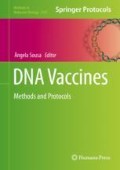Abstract
DNA vaccines have been used as a promising strategy for delivery of immunogenic and immunomodulatory molecules into the host cells. Although, there are some obstacles involving the capability of the plasmid vector to reach the cell nucleus in great number to promote the expected benefits. In order to improve the delivery and, consequently, increase the expression levels of the target proteins carried by DNA vaccines, alternative methodologies have been explored, including the use of non-pathogenic bacteria as delivery vectors to carry, deliver, and protect the DNA from degradation, enhancing plasmid expression.
Access this chapter
Tax calculation will be finalised at checkout
Purchases are for personal use only
References
Ingolotti M, Kawalekar O, Shedlock DJ et al (2010) DNA vaccines for targeting bacterial infections. Expert Rev Vaccines 9:747–763
Landete JM (2017) A review of food-grade vectors in lactic acid bacteria: from the laboratory to their application. Crit Rev Biotechnol 37:296–308
Hobernik D, Bros M (2018) DNA vaccines—how far from clinical use? Int J Mol Sci 19:3605
Kutzler MA, Weiner DB (2008) DNA vaccines: ready for prime time? Nat Rev Genet 9:776–788
Fuller DH, Loudon P, Schmaljohn C (2006) Preclinical and clinical progress of particle-mediated DNA vaccines for infectious diseases. Methods 40:86–97
Vasan S, Hurley A, Schlesinger SJ et al (2011) In vivo electroporation enhances the immunogenicity of an HIV-1 DNA vaccine candidate in healthy volunteers. PLoS One 6:e19252
Wang S, Zhang C, Zhang L et al (2008) The relative immunogenicity of DNA vaccines delivered by the intramuscular needle injection, electroporation and gene gun methods. Vaccine 26:2100–2110
Pereira VB, Saraiva TDL, Souza BM et al (2015) Development of a new DNA vaccine based on mycobacterial ESAT-6 antigen delivered by recombinant invasive Lactococcus lactis FnBPA+. Appl Microbiol Biotechnol 99:1817–1826
Mowat AM, Agace WW (2014) Regional specialization within the intestinal immune system. Nat Rev Immunol 14:667–685
Wyszyńska A, Kobierecka P, Bardowski J et al (2015) Lactic acid bacteria—20 years exploring their potential as live vectors for mucosal vaccination. Appl Microbiol Biotechnol 99:2967–2977
Schaffner W (1980) Direct transfer of cloned genes from bacteria to mammalian cells. Proc Natl Acad Sci U S A 77:2163–2167
Courvalin P, Goussard S, Grillot-Courvalin C (1995) Gene transfer from bacteria to mammalian cells. C R Acad Sci III 318:1207–1212
Pilgrim S, Stritzker J, Schoen C et al (2003) Bactofection of mammalian cells by Listeria monocytogenes: improvement and mechanism of DNA delivery. Gene Ther 10:2036–2045
Daudel D, Weidinger G, Spreng S (2007) Use of attenuated bacteria as delivery vectors for DNA vaccines. Expert Rev Vaccines 6:97–110
Dunham SP (2002) The application of nucleic acid vaccines in veterinary medicine. Res Vet Sci 73:9–16
Wells JM, Mercenier A (2008) Mucosal delivery of therapeutic and prophylactic molecules using lactic acid bacteria. Nat Rev Microbiol 6:349–362
Bermúdez-Humarán LG, Aubry C, Motta J-P et al (2013) Engineering lactococci and lactobacilli for human health. Curr Opin Microbiol 16:278–283
Sanders ME (2003) Probiotics: considerations for human health. Nutr Rev 61:91–99
Hill C, Guarner F, Reid G et al (2014) The International Scientific Association for Probiotics and Prebiotics consensus statement on the scope and appropriate use of the term probiotic. Nat Rev Gastroenterol Hepatol 11:506–514
Mercenier A, Müller-Alouf H, Grangette C (2000) Lactic acid bacteria as live vaccines. Curr Issues Mol Biol 2(1):17–25
Faudzi H, Faroque H, Chia SL et al (2018) Lactococcus lactis: LAB model organism for bacteria-mediated therapeutic strategies. Asia-Pacific J Mol Biol Biotechnol 26(1):1–10
Guimarães VD, Innocentin S, Lefevre F et al (2006) Use of native Lactococci as vehicles for delivery of DNA into mammalian epithelial cells. Appl Environ Microbiol 72:7091–7097
Chatel J-M, Pothelune L, Ah-Leung S et al (2008) In vivo transfer of plasmid from food-grade transiting lactococci to murine epithelial cells. Gene Ther 15:1184–1190
Guimarães V, Innocentin S, Chatel J-M et al (2009) A new plasmid vector for DNA delivery using lactococci. Genet Vaccines Ther 7:4
Chiabai MJ, Almeida JF, de Azevedo MGD et al (2019) Mucosal delivery of Lactococcus lactis carrying an anti-TNF scFv expression vector ameliorates experimental colitis in mice. BMC Biotechnol 19:38
Tao L, Pavlova SI, Ji X et al (2011) A novel plasmid for delivering genes into mammalian cells with noninvasive food and commensal lactic acid bacteria. Plasmid 65:8–14
Mancha-Agresti P, Drumond MM, Carmo FLR d et al (2017) A new broad range plasmid for DNA delivery in eukaryotic cells using lactic acid bacteria: in vitro and in vivo assays. Mol Ther Methods Clin Dev 4:83–91
Coelho-Rocha ND, de Castro CP, de Jesus LCL et al (2018) Microencapsulation of lactic acid bacteria improves the gastrointestinal delivery and in situ expression of recombinant fluorescent protein. Front Microbiol 9:2398
Yagnik B, Padh H, Desai P (2016) Construction of a new shuttle vector for DNA delivery into mammalian cells using non-invasive Lactococcus lactis. Microbes Infect 18:237–244
Yagnik B, Sharma D, Padh H et al (2018) In vivo delivery of pPERDBY to BALB/c mice by LacVax® DNA-I and comparison of elicited immune response with conventional immunization methods. Gene Ther 25:485–496
Author information
Authors and Affiliations
Corresponding author
Editor information
Editors and Affiliations
Rights and permissions
Copyright information
© 2021 Springer Science+Business Media, LLC, part of Springer Nature
About this protocol
Cite this protocol
Coelho-Rocha, N.D. et al. (2021). Main Features of DNA-Based Vectors for Use in Lactic Acid Bacteria and Update Protocols. In: Sousa, Â. (eds) DNA Vaccines. Methods in Molecular Biology, vol 2197. Humana, New York, NY. https://doi.org/10.1007/978-1-0716-0872-2_16
Download citation
DOI: https://doi.org/10.1007/978-1-0716-0872-2_16
Published:
Publisher Name: Humana, New York, NY
Print ISBN: 978-1-0716-0871-5
Online ISBN: 978-1-0716-0872-2
eBook Packages: Springer Protocols

